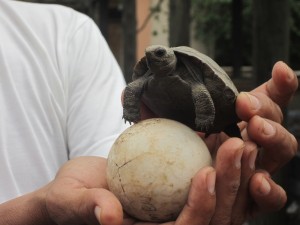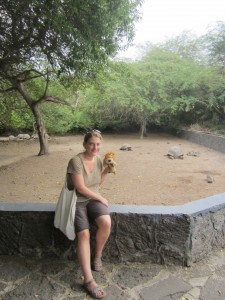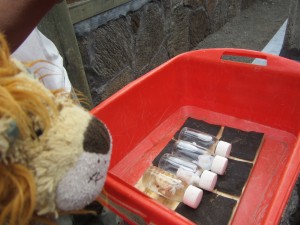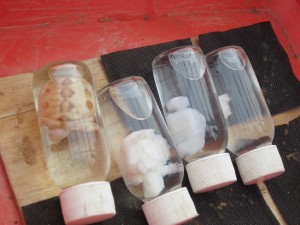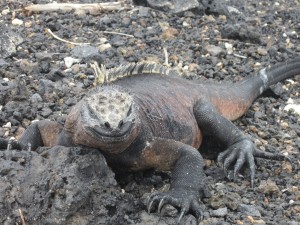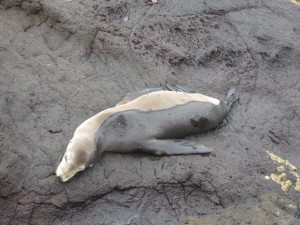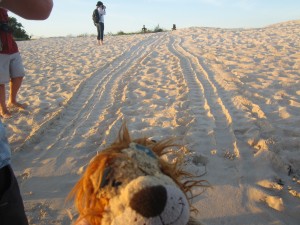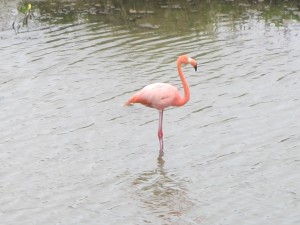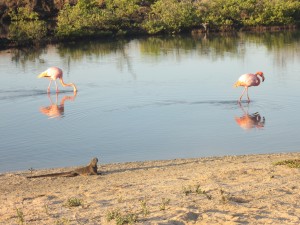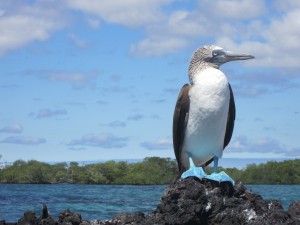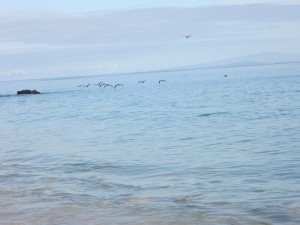Lewis the Lion discovered that there were more than 5,000 species of animals in the Galapagos Islands. However, he wants to share with you some fact-files about 3 of his favourite ones as well as telling you a bit about some of the other amazing animals there.
Tortoises
Number of different species on the Galapagos Islands: 10
Can live up to: 200 years old
Can weigh up to: 200 kg
Gestation (pregnancy) lasts for: 9 months
As you discovered in one of Lewis the Lion’s last blogs, tortoises are an endangered species and so in the Galapagos Islands there is a special centre which helps to protect and breed the tortoises. The tortoise eggs are especially vulnerable to predators so the centre helps to protect them in a safe environment.
Iguanas
Number of different species on the Galapagos Islands: Land iguanas 1-4 sub-species, Marine iguanas 1-7 sub-species
Can live up to: 80 – 85 years old
Can weigh up to: 12 – 13 kg
Gestation (pregnancy) lasts for: 3 months
Lewis the Lion just loved the marine iguanas as he thought that they almost looked like cartoon characters or could imagine them being used as characters in something like Harry Potter or Lord of the Rings!
Each one had its own face and personality and as they got back to dry land, they would sunbathe in their hundreds, snuggling up to each other to warm up. You might get a bit of a shock as they would suddenly spit out! However, they didn’t mind you being there, they were just simply clearing the salt from their nostrils!
Lewis the Lion watches hundreds of sunbathing marine iguana
Sea lions
Number of different species on the Galapagos Islands: 1
Can live up to: 20 -25 years old
Can weigh up to: 45 – 100 kg
Gestation (pregnancy) lasts for: 9 months
Lewis the Lion thought it was funny how the sea lions were black when wet but turned a kind of brown colour when dry.
He thought that they were some of the noisiest creatures he had ever heard before. One time, he could just hear them, hidden away between the mangrove treeListen to them here on these video clips, including one clip where they seem to kiss!
Lewis the Lion can hear some noisy sea-lions through the mangrove trees
Lewis the Lion sees two sea-lions kiss
Lewis hopes you’ve enjoyed the information he’s shared with you on three of his favourite Galapagos animals? He’s now going to tell you about some other animals he really enjoyed seeing too. Perhaps you could do some of your own research and create a fact file for the too? Then you could go on to play one of Lewis the Lion’s favourite games with your friends, Top Trumps, with the information that you find!
Giant Green Turtles
Lewis was also lucky enough to see many giant green turtles swimming in Elisabeth Bay on the island of Isabela. (These should not be confused with tortoises which are land based). Lewis thought it was fabulous how clear the water was so that you could see these huge creatures gliding through the water. Sometimes they would come up to the surface and poke their heads out of the water and at other times they would flap their flippers to take them to the bottom of the sea: it was if they knew they had an audience watching them!
Click here to see them swim smoothly by.
Lewis the Lion sees a giant turtle swim by
Lewis the Lion sees another giant turtle swim by
One of the most magical things that Lewis the Lion saw on his trip to the Galapagos Islands was that early one morning, as dawn was breaking, he landed in the zodiac on a sandy beach where the turtles come to lay their eggs. You could see where they had dragged their bodies up onto the sand.
Flamingos
Lewis thought that these animals looked so graceful as they waded through the water, almost like ballerinas with their heads held high, whilst bending and straightening their legs out in front of them. However, as he looked closely at them, he chucked to himself. To his mind it looked as if their knee joints had been put on backwards! How funny!
Furthermore, he giggled to himself again when he saw them fly for the first time. Whilst they had the elegance of emperors whilst walking through the water, this was reduced to cumbersome flying machines as they propelled themselves across the sky. They seemed to look very awkward and unco-ordinated.
Here is a video clip of a flamingo flying in!
Lewis the Lion watches a flying flamingo on the Galapagos Islands
They also were really squawky birds which Lewis had not expected at all. Lewis heard them in full voice one morning as they seemed to call to each other to join them in a good feeding pool. He also learned that the pinker they were, the better they were at finding food as it was the food itself that gave them their pink colour.
One of the other things that Lewis the Lion loved about being in the Galapagos Islands was that he could watch on flamingos feeding whilst at the same time watch marine iguanas sunbathing on the sand. Wonderful!
Blue-footed boobies
As well as the giant tortoises, perhaps one of the most acclaimed animal found in the Galapagos Islands are the blue-footed boobies. Even if they had a funny sounding name, Lewis the Lion just thought they were the most incredible birds for a couple of reasons.
First of all, they had the brightest blue feet and Lewis the Lion wondered why they had adapted in this way? He didn’t ever find out why but maybe you can? Whatever the reason, he thought they were one of nature’s finest looking birds.
Secondly, Lewis the Lion thought it was an awesome sight to see the blue-footed boobies go fishing en masse over the sea early one morning on Bachas Beach. At first he didn’t even realise that they were blue-footed boobies because they had their feet tucked in tightly under their feathers as they aimed to be as streamlined as possible! As they glided over the water, their bellies barely skimmed the surface of the water as they inspected the water below for shoals of fish. Eventually, they would swoop together in a massive fishing exercise. Lewis the Lion just couldn’t believe how many there were: literally, the blue-footed boobies seemed to fly by in their thousands. Again, a wondrous sight to behold!
Here you can see some of the blue-footed boobies flying by along with Lewis the Lion.

